Research Methods for Language and Linguistics: Listening Study
VerifiedAdded on 2022/08/22
|7
|1259
|20
Report
AI Summary
This report details a research methodology for investigating effective listening in language and linguistics. It outlines research questions focused on teaching listening, different listening types, and factors influencing listening text difficulty. The methodology includes a null and alternative hypothesis, defining variables like 'effective listening' and 'types of listening.' The research design utilizes classroom observations, transcripts, and video recordings for data collection, employing instruments such as questionnaires and interviews. Participants include teachers and students, with a sample size of 15 instructors and 50 students. Data analysis involves both qualitative and quantitative methods, examining patterns to address research questions and determine the validity of the hypotheses. Qualitative data analysis will be conducted using data collected from classroom observations, and for quantitative data analysis, data collected from video recordings, field notes, and transcripts will be analyzed using statistical tools. The study aims to refine teaching philosophies and pedagogical approaches in the field of language and linguistics, contributing to a deeper understanding of effective listening strategies.
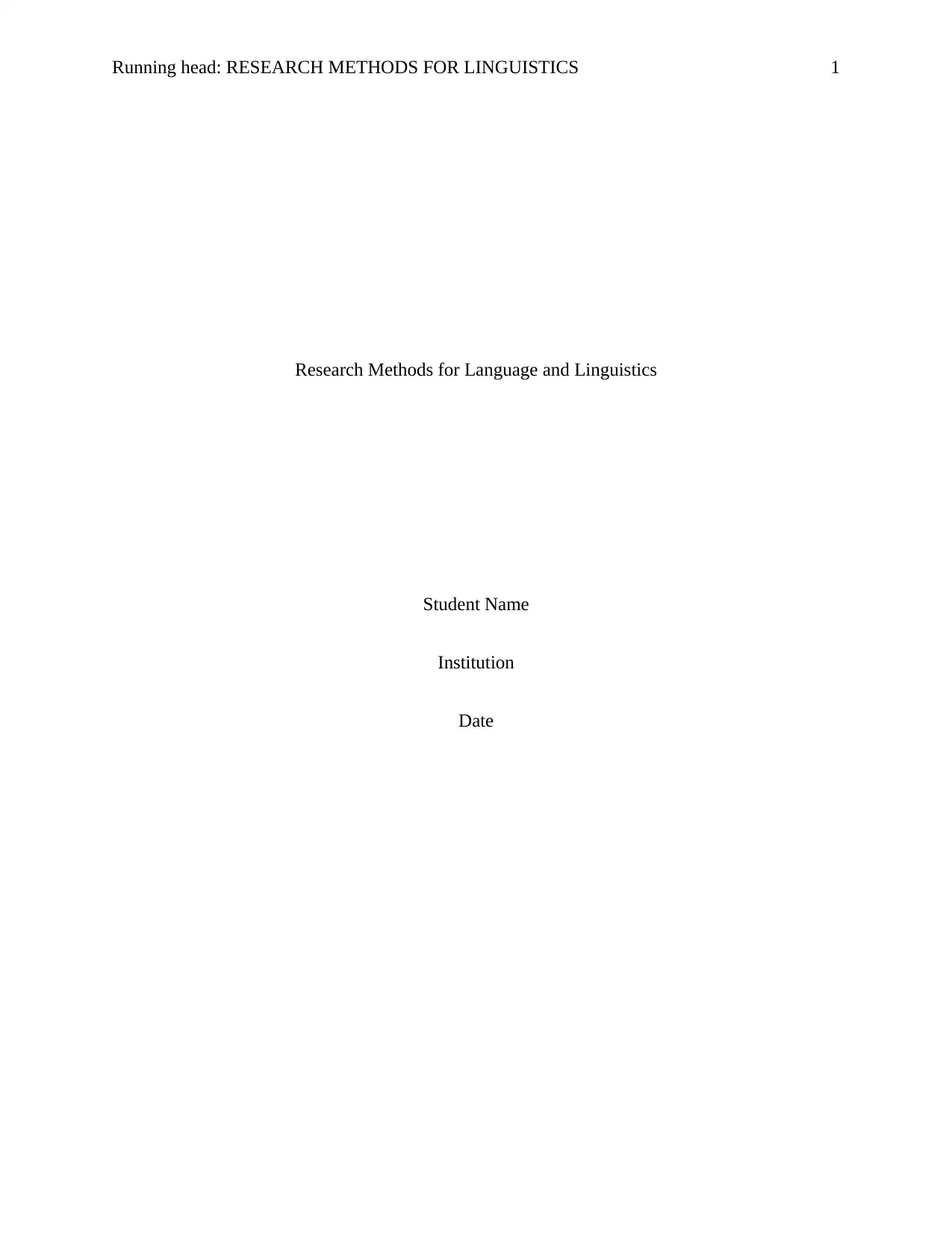
Running head: RESEARCH METHODS FOR LINGUISTICS 1
Research Methods for Language and Linguistics
Student Name
Institution
Date
Research Methods for Language and Linguistics
Student Name
Institution
Date
Paraphrase This Document
Need a fresh take? Get an instant paraphrase of this document with our AI Paraphraser
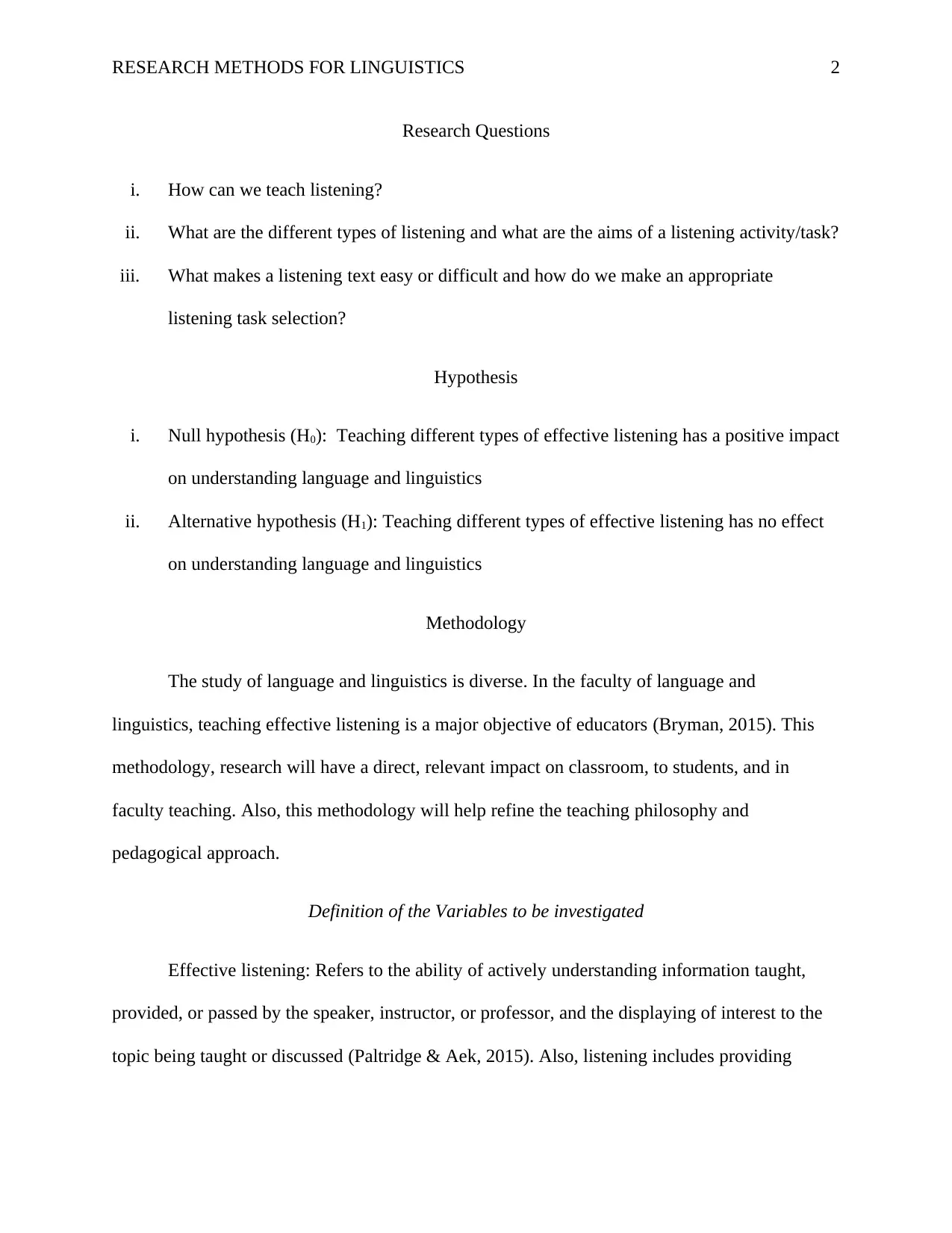
RESEARCH METHODS FOR LINGUISTICS 2
Research Questions
i. How can we teach listening?
ii. What are the different types of listening and what are the aims of a listening activity/task?
iii. What makes a listening text easy or difficult and how do we make an appropriate
listening task selection?
Hypothesis
i. Null hypothesis (H0): Teaching different types of effective listening has a positive impact
on understanding language and linguistics
ii. Alternative hypothesis (H1): Teaching different types of effective listening has no effect
on understanding language and linguistics
Methodology
The study of language and linguistics is diverse. In the faculty of language and
linguistics, teaching effective listening is a major objective of educators (Bryman, 2015). This
methodology, research will have a direct, relevant impact on classroom, to students, and in
faculty teaching. Also, this methodology will help refine the teaching philosophy and
pedagogical approach.
Definition of the Variables to be investigated
Effective listening: Refers to the ability of actively understanding information taught,
provided, or passed by the speaker, instructor, or professor, and the displaying of interest to the
topic being taught or discussed (Paltridge & Aek, 2015). Also, listening includes providing
Research Questions
i. How can we teach listening?
ii. What are the different types of listening and what are the aims of a listening activity/task?
iii. What makes a listening text easy or difficult and how do we make an appropriate
listening task selection?
Hypothesis
i. Null hypothesis (H0): Teaching different types of effective listening has a positive impact
on understanding language and linguistics
ii. Alternative hypothesis (H1): Teaching different types of effective listening has no effect
on understanding language and linguistics
Methodology
The study of language and linguistics is diverse. In the faculty of language and
linguistics, teaching effective listening is a major objective of educators (Bryman, 2015). This
methodology, research will have a direct, relevant impact on classroom, to students, and in
faculty teaching. Also, this methodology will help refine the teaching philosophy and
pedagogical approach.
Definition of the Variables to be investigated
Effective listening: Refers to the ability of actively understanding information taught,
provided, or passed by the speaker, instructor, or professor, and the displaying of interest to the
topic being taught or discussed (Paltridge & Aek, 2015). Also, listening includes providing
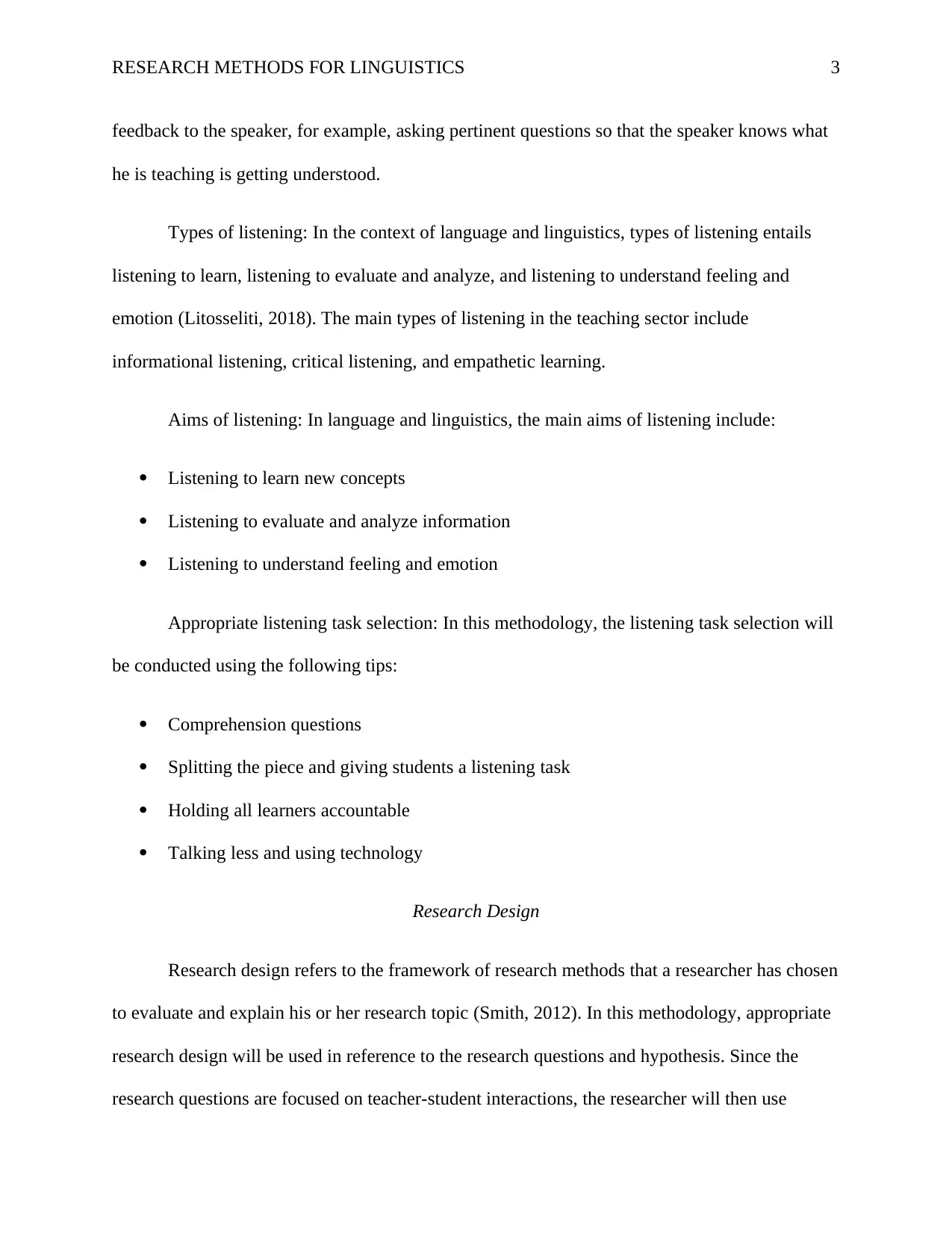
RESEARCH METHODS FOR LINGUISTICS 3
feedback to the speaker, for example, asking pertinent questions so that the speaker knows what
he is teaching is getting understood.
Types of listening: In the context of language and linguistics, types of listening entails
listening to learn, listening to evaluate and analyze, and listening to understand feeling and
emotion (Litosseliti, 2018). The main types of listening in the teaching sector include
informational listening, critical listening, and empathetic learning.
Aims of listening: In language and linguistics, the main aims of listening include:
Listening to learn new concepts
Listening to evaluate and analyze information
Listening to understand feeling and emotion
Appropriate listening task selection: In this methodology, the listening task selection will
be conducted using the following tips:
Comprehension questions
Splitting the piece and giving students a listening task
Holding all learners accountable
Talking less and using technology
Research Design
Research design refers to the framework of research methods that a researcher has chosen
to evaluate and explain his or her research topic (Smith, 2012). In this methodology, appropriate
research design will be used in reference to the research questions and hypothesis. Since the
research questions are focused on teacher-student interactions, the researcher will then use
feedback to the speaker, for example, asking pertinent questions so that the speaker knows what
he is teaching is getting understood.
Types of listening: In the context of language and linguistics, types of listening entails
listening to learn, listening to evaluate and analyze, and listening to understand feeling and
emotion (Litosseliti, 2018). The main types of listening in the teaching sector include
informational listening, critical listening, and empathetic learning.
Aims of listening: In language and linguistics, the main aims of listening include:
Listening to learn new concepts
Listening to evaluate and analyze information
Listening to understand feeling and emotion
Appropriate listening task selection: In this methodology, the listening task selection will
be conducted using the following tips:
Comprehension questions
Splitting the piece and giving students a listening task
Holding all learners accountable
Talking less and using technology
Research Design
Research design refers to the framework of research methods that a researcher has chosen
to evaluate and explain his or her research topic (Smith, 2012). In this methodology, appropriate
research design will be used in reference to the research questions and hypothesis. Since the
research questions are focused on teacher-student interactions, the researcher will then use
⊘ This is a preview!⊘
Do you want full access?
Subscribe today to unlock all pages.

Trusted by 1+ million students worldwide
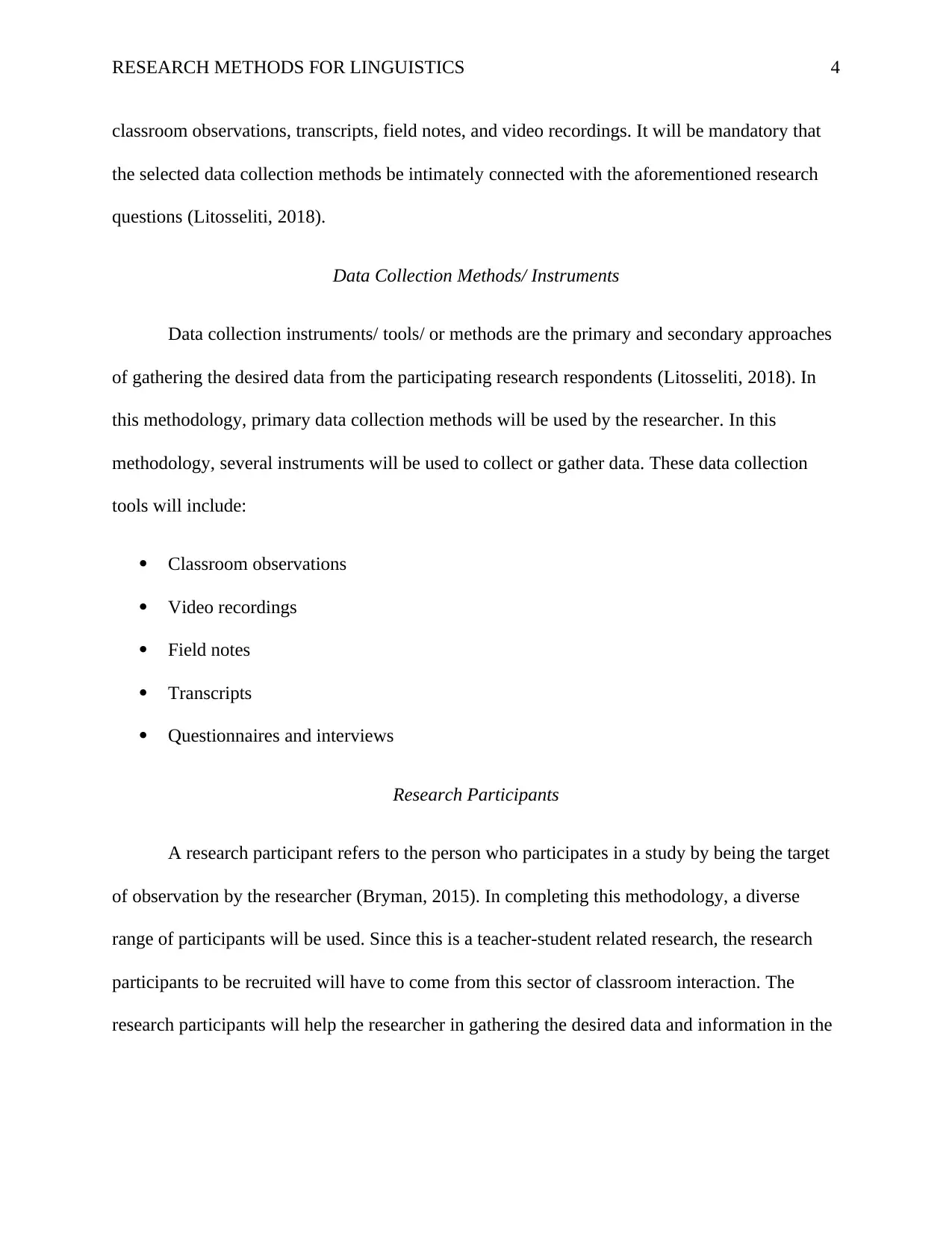
RESEARCH METHODS FOR LINGUISTICS 4
classroom observations, transcripts, field notes, and video recordings. It will be mandatory that
the selected data collection methods be intimately connected with the aforementioned research
questions (Litosseliti, 2018).
Data Collection Methods/ Instruments
Data collection instruments/ tools/ or methods are the primary and secondary approaches
of gathering the desired data from the participating research respondents (Litosseliti, 2018). In
this methodology, primary data collection methods will be used by the researcher. In this
methodology, several instruments will be used to collect or gather data. These data collection
tools will include:
Classroom observations
Video recordings
Field notes
Transcripts
Questionnaires and interviews
Research Participants
A research participant refers to the person who participates in a study by being the target
of observation by the researcher (Bryman, 2015). In completing this methodology, a diverse
range of participants will be used. Since this is a teacher-student related research, the research
participants to be recruited will have to come from this sector of classroom interaction. The
research participants will help the researcher in gathering the desired data and information in the
classroom observations, transcripts, field notes, and video recordings. It will be mandatory that
the selected data collection methods be intimately connected with the aforementioned research
questions (Litosseliti, 2018).
Data Collection Methods/ Instruments
Data collection instruments/ tools/ or methods are the primary and secondary approaches
of gathering the desired data from the participating research respondents (Litosseliti, 2018). In
this methodology, primary data collection methods will be used by the researcher. In this
methodology, several instruments will be used to collect or gather data. These data collection
tools will include:
Classroom observations
Video recordings
Field notes
Transcripts
Questionnaires and interviews
Research Participants
A research participant refers to the person who participates in a study by being the target
of observation by the researcher (Bryman, 2015). In completing this methodology, a diverse
range of participants will be used. Since this is a teacher-student related research, the research
participants to be recruited will have to come from this sector of classroom interaction. The
research participants will help the researcher in gathering the desired data and information in the
Paraphrase This Document
Need a fresh take? Get an instant paraphrase of this document with our AI Paraphraser
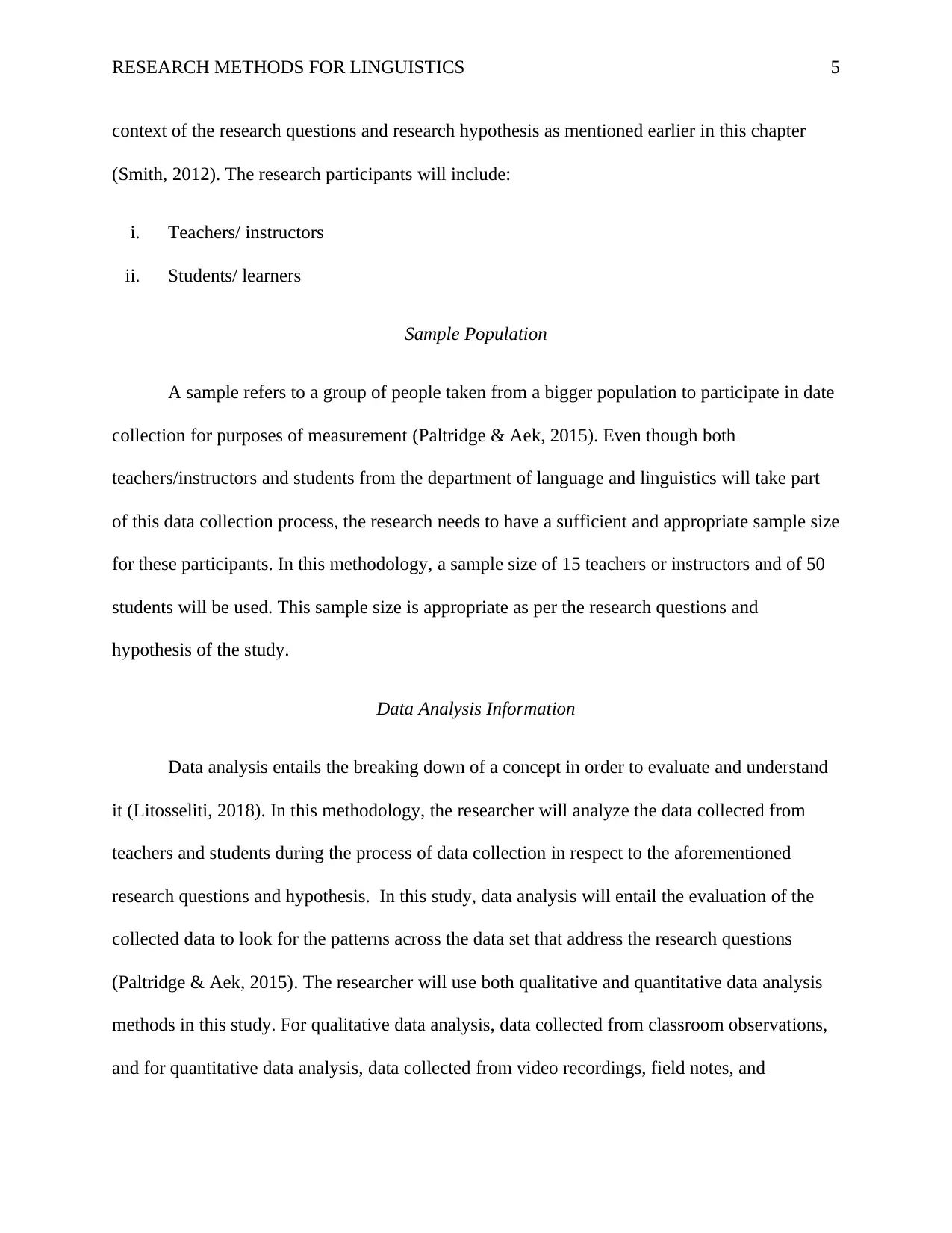
RESEARCH METHODS FOR LINGUISTICS 5
context of the research questions and research hypothesis as mentioned earlier in this chapter
(Smith, 2012). The research participants will include:
i. Teachers/ instructors
ii. Students/ learners
Sample Population
A sample refers to a group of people taken from a bigger population to participate in date
collection for purposes of measurement (Paltridge & Aek, 2015). Even though both
teachers/instructors and students from the department of language and linguistics will take part
of this data collection process, the research needs to have a sufficient and appropriate sample size
for these participants. In this methodology, a sample size of 15 teachers or instructors and of 50
students will be used. This sample size is appropriate as per the research questions and
hypothesis of the study.
Data Analysis Information
Data analysis entails the breaking down of a concept in order to evaluate and understand
it (Litosseliti, 2018). In this methodology, the researcher will analyze the data collected from
teachers and students during the process of data collection in respect to the aforementioned
research questions and hypothesis. In this study, data analysis will entail the evaluation of the
collected data to look for the patterns across the data set that address the research questions
(Paltridge & Aek, 2015). The researcher will use both qualitative and quantitative data analysis
methods in this study. For qualitative data analysis, data collected from classroom observations,
and for quantitative data analysis, data collected from video recordings, field notes, and
context of the research questions and research hypothesis as mentioned earlier in this chapter
(Smith, 2012). The research participants will include:
i. Teachers/ instructors
ii. Students/ learners
Sample Population
A sample refers to a group of people taken from a bigger population to participate in date
collection for purposes of measurement (Paltridge & Aek, 2015). Even though both
teachers/instructors and students from the department of language and linguistics will take part
of this data collection process, the research needs to have a sufficient and appropriate sample size
for these participants. In this methodology, a sample size of 15 teachers or instructors and of 50
students will be used. This sample size is appropriate as per the research questions and
hypothesis of the study.
Data Analysis Information
Data analysis entails the breaking down of a concept in order to evaluate and understand
it (Litosseliti, 2018). In this methodology, the researcher will analyze the data collected from
teachers and students during the process of data collection in respect to the aforementioned
research questions and hypothesis. In this study, data analysis will entail the evaluation of the
collected data to look for the patterns across the data set that address the research questions
(Paltridge & Aek, 2015). The researcher will use both qualitative and quantitative data analysis
methods in this study. For qualitative data analysis, data collected from classroom observations,
and for quantitative data analysis, data collected from video recordings, field notes, and
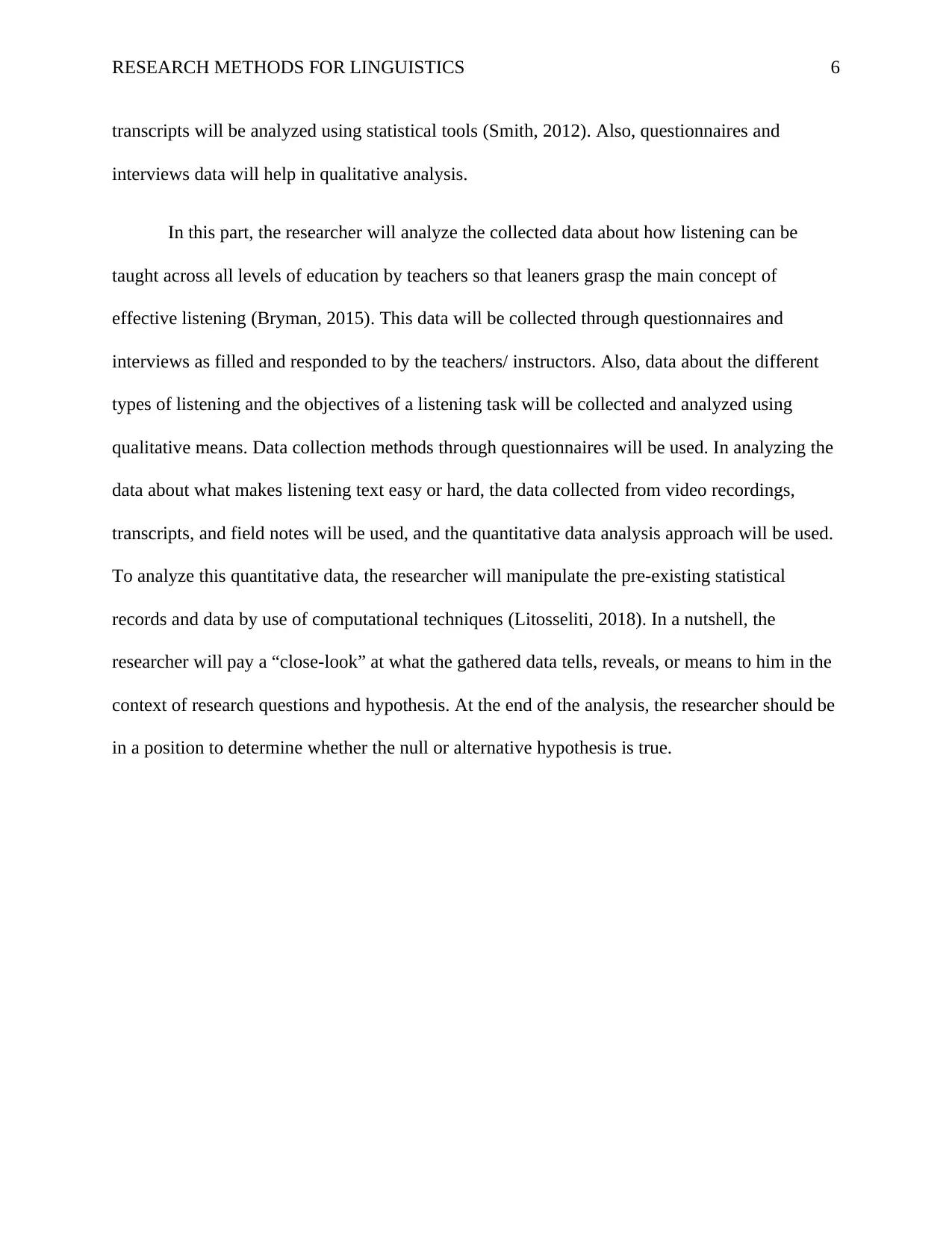
RESEARCH METHODS FOR LINGUISTICS 6
transcripts will be analyzed using statistical tools (Smith, 2012). Also, questionnaires and
interviews data will help in qualitative analysis.
In this part, the researcher will analyze the collected data about how listening can be
taught across all levels of education by teachers so that leaners grasp the main concept of
effective listening (Bryman, 2015). This data will be collected through questionnaires and
interviews as filled and responded to by the teachers/ instructors. Also, data about the different
types of listening and the objectives of a listening task will be collected and analyzed using
qualitative means. Data collection methods through questionnaires will be used. In analyzing the
data about what makes listening text easy or hard, the data collected from video recordings,
transcripts, and field notes will be used, and the quantitative data analysis approach will be used.
To analyze this quantitative data, the researcher will manipulate the pre-existing statistical
records and data by use of computational techniques (Litosseliti, 2018). In a nutshell, the
researcher will pay a “close-look” at what the gathered data tells, reveals, or means to him in the
context of research questions and hypothesis. At the end of the analysis, the researcher should be
in a position to determine whether the null or alternative hypothesis is true.
transcripts will be analyzed using statistical tools (Smith, 2012). Also, questionnaires and
interviews data will help in qualitative analysis.
In this part, the researcher will analyze the collected data about how listening can be
taught across all levels of education by teachers so that leaners grasp the main concept of
effective listening (Bryman, 2015). This data will be collected through questionnaires and
interviews as filled and responded to by the teachers/ instructors. Also, data about the different
types of listening and the objectives of a listening task will be collected and analyzed using
qualitative means. Data collection methods through questionnaires will be used. In analyzing the
data about what makes listening text easy or hard, the data collected from video recordings,
transcripts, and field notes will be used, and the quantitative data analysis approach will be used.
To analyze this quantitative data, the researcher will manipulate the pre-existing statistical
records and data by use of computational techniques (Litosseliti, 2018). In a nutshell, the
researcher will pay a “close-look” at what the gathered data tells, reveals, or means to him in the
context of research questions and hypothesis. At the end of the analysis, the researcher should be
in a position to determine whether the null or alternative hypothesis is true.
⊘ This is a preview!⊘
Do you want full access?
Subscribe today to unlock all pages.

Trusted by 1+ million students worldwide
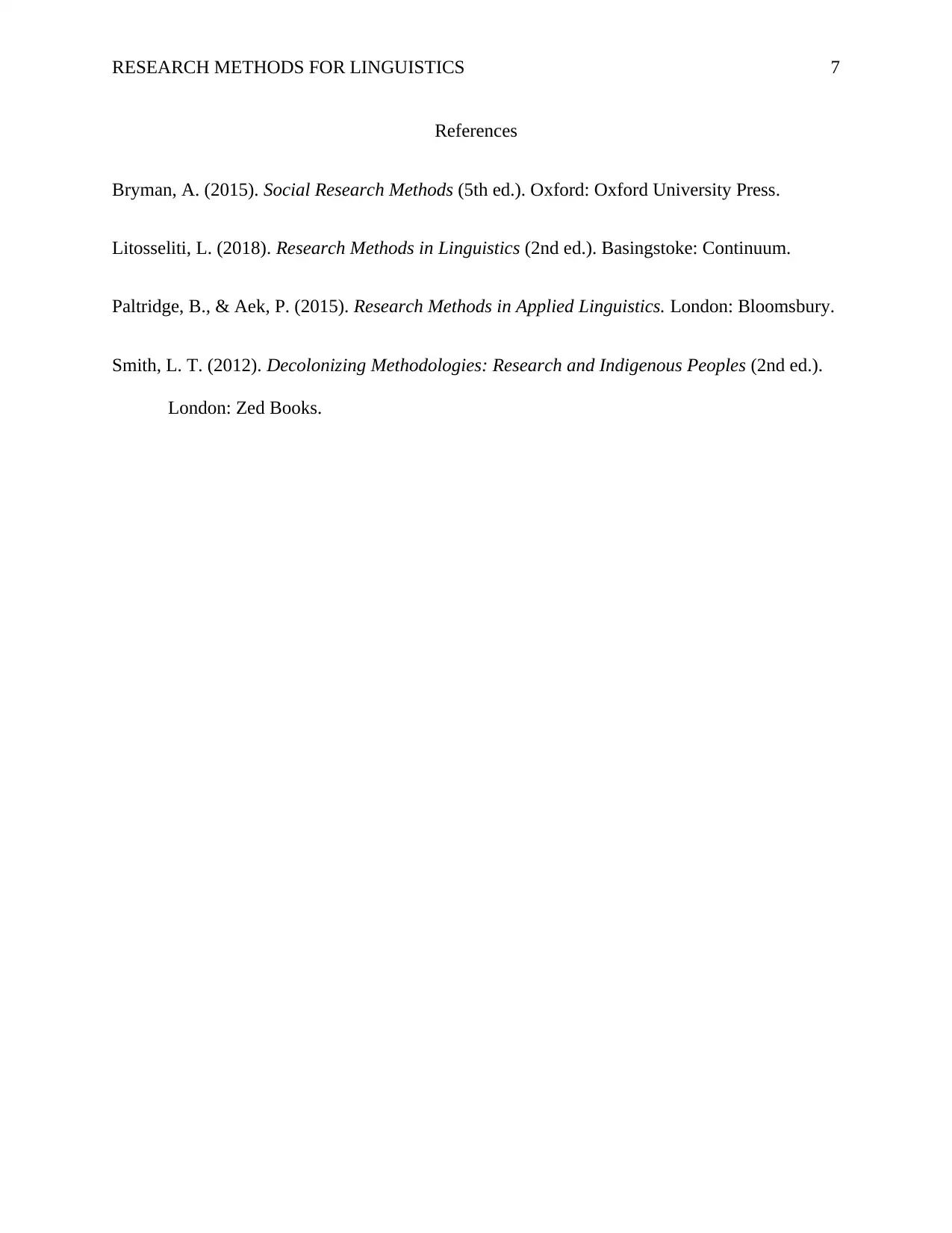
RESEARCH METHODS FOR LINGUISTICS 7
References
Bryman, A. (2015). Social Research Methods (5th ed.). Oxford: Oxford University Press.
Litosseliti, L. (2018). Research Methods in Linguistics (2nd ed.). Basingstoke: Continuum.
Paltridge, B., & Aek, P. (2015). Research Methods in Applied Linguistics. London: Bloomsbury.
Smith, L. T. (2012). Decolonizing Methodologies: Research and Indigenous Peoples (2nd ed.).
London: Zed Books.
References
Bryman, A. (2015). Social Research Methods (5th ed.). Oxford: Oxford University Press.
Litosseliti, L. (2018). Research Methods in Linguistics (2nd ed.). Basingstoke: Continuum.
Paltridge, B., & Aek, P. (2015). Research Methods in Applied Linguistics. London: Bloomsbury.
Smith, L. T. (2012). Decolonizing Methodologies: Research and Indigenous Peoples (2nd ed.).
London: Zed Books.
1 out of 7
Related Documents
Your All-in-One AI-Powered Toolkit for Academic Success.
+13062052269
info@desklib.com
Available 24*7 on WhatsApp / Email
![[object Object]](/_next/static/media/star-bottom.7253800d.svg)
Unlock your academic potential
Copyright © 2020–2025 A2Z Services. All Rights Reserved. Developed and managed by ZUCOL.





